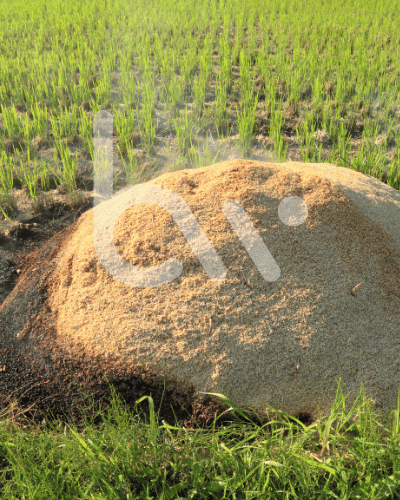
Rice Husk Ash
Rice husk ash (RHA) is a byproduct formed through the burning or combustion of rice husks, the protective outer layers of rice grains. This powdery substance, obtained during processes like power generation or rice milling, boasts a notable characteristic—high silica content. Typically containing a substantial amount of amorphous silica (SiO2) along with other minerals, the silica content can vary from 80% to 95% based on the specific burning conditions. The elevated silica content renders rice husk ash valuable for diverse applications across various industries.



Used For
Construction Advancements
Rice husk ash emerges as a valuable supplementary material in construction, enriching the production of concrete and allied materials. Its incorporation enhances concrete strength, durability, and workability while reducing cement usage, contributing to sustainable construction practices.
Environmental Remediation
The abundant silica content in rice husk ash makes it a valuable asset in wastewater treatment endeavors. Utilized as an adsorbent, it effectively purifies contaminated water by adsorbing heavy metals and pollutants, contributing to environmental preservation and water quality improvement.
Industrial Applications
Rice husk ash finds its niche in ceramic and refractory industries, leveraging its high silica content to enhance mechanical properties and reduce firing temperatures in ceramic production. Its versatility makes it a sought-after component in the creation of ceramics and refractory materials, advancing industrial processes with efficiency and sustainability.
People Also View
Hydroponic
Coconut Peat
Coir Fiber
Coconut Derivative
Charcoal
Others
What can rice husk ash be used for?
1. Construction Industry
Cement and Concrete Production: RHA is used as a pozzolanic material to improve the properties of cement and concrete. It enhances the strength and durability of concrete and reduces the environmental impact by partially replacing cement with a more sustainable material.
Bricks and Refractory Materials: RHA can be used in the production of refractory bricks, which are heat-resistant and used in furnaces, kilns, and other high-temperature environments.
2. Agriculture
Soil Amendment: RHA is used to improve soil quality. It acts as a soil conditioner, increasing water retention, improving drainage, and enhancing the availability of essential nutrients. It can also help in the control of soil pH.
Fertilizer Additive: Due to its high silica content, RHA can be mixed with other organic fertilizers to increase the effectiveness of fertilization.
3. Water Treatment
Absorbent for Contaminants: The high silica content makes RHA useful in water purification. It can be used to remove heavy metals and other contaminants from water, acting as an adsorbent in filtration processes.
4. Industrial Applications
Silicon Production: RHA is used in the production of silicon compounds, which are important in various industrial processes, such as the manufacture of electronics and solar panels.
Insulation: RHA is used as an insulating material in high-temperature environments, especially in steel mills, where its properties help protect equipment from temperature fluctuations.
5. Energy Production
Bioenergy Production: Rice husk ash can be used as part of biomass energy systems, providing a renewable source of energy through combustion. The ash left behind can be used in other applications or treated further to extract valuable materials.
6. Carbon Sequestration
Environmental Benefits: By utilizing rice husk ash, carbon emissions from rice husk burning can be reduced. The process of burning rice husks in controlled conditions creates a more sustainable use of agricultural waste.
7. Ceramics
Ceramic Production: The silica in RHA makes it suitable for use in the ceramics industry, where it is used in the manufacturing of tiles, porcelain, and other ceramic products.
8. Activated Carbon
Production of Activated Carbon: RHA can be processed to produce activated carbon, which has uses in filtration, purification, and other industrial processes.
9. Construction and Road Works
Road Stabilization: In some regions, RHA is used for stabilizing roads and pavement construction by mixing it with asphalt and other materials to increase strength and durability.
10. Sustainability
Waste Utilization: By using rice husk ash, agricultural waste from rice milling is effectively utilized, helping to reduce environmental pollution and providing a sustainable alternative to traditional construction materials and fertilizers.
What is reice husk ash?
Rice husk ash (RHA) is the powdery residue left after burning rice husks at high temperatures. It is mainly composed of silica (SiO2), with small amounts of other minerals. RHA is used in various industries, such as construction (for making concrete), agriculture (to improve soil), and water treatment (to filter contaminants), due to its high silica content and absorbent properties.
